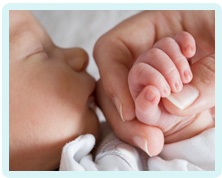
Pelvic Floor Injuries During Childbirth
In this article we explore pelvic floor injuries during childbirth in more detail, explaining what the pelvic floor is, why it gets damaged during a vaginal delivery and what problems might arise.
What is the pelvic floor?
The pelvic floor is a group of muscles, tissues and ligaments found in both men and women. It is located in the pelvis and stretches from the pubic bone at the front of the body to the base of the spine at the back of the body.
The pelvic floor is very important because it supports the pelvic organs, including the bladder, bowel and uterus. It therefore enables urinary continence, faecal continence and sexual function.
Pelvic floor injuries because of childbirth
The pelvic floor is often described as a sling or trampoline because it can stretch and rebound easily. However, pregnancy and childbirth can put the pelvic floor under so much strain that it is unable to 'bounce back', resulting in pelvic floor injuries.
Pregnancy damages the pelvic floor because the weight of the unborn baby puts the muscles under unrelenting pressure, causing them to weaken. A vaginal delivery can also lead to injuries because as the baby's head begins to crown it will stretch the pelvic floor, potentially resulting in tearing and pudendal nerve damage. Again, this will weaken the pelvic floor.
The trauma sustained by the pelvic floor during pregnancy and childbirth can lead to pelvic floor dysfunction. This can be characterised by a number of physical problems, such as:
- Urinary urgency and incontinence
- Poor flow of urine with difficulty emptying the bladder
- Constipation
- Faecal incontinence
- Anal/vaginal/uterine prolapse
- Chronic pelvic pain
- Painful sexual intercourse
Pelvic floor exercises during pregnancy and after childbirth can help to strengthen the muscles, limiting/improving pelvic floor dysfunction.
Nevertheless, some experts suggest that inherited factors (such as collagen deficiency) can increase the risk of pelvic floor injuries in some women. A recent study has also found that women who give birth later in life are more likely to sustain pelvic floor injuries. This is because the muscles become less stretchy with age, making them more likely to tear.
Tears during childbirth
The perineum and anal sphincter muscles can also tear during a vaginal delivery when the baby's head and shoulders pass through the vaginal opening. Severe tears can cause similar problems to pelvic floor injuries, such as faecal incontinence, pain during intercourse and pain. These problems will be significantly worse if the perineal tear is not diagnosed and treated within 24 hours of the birth.
Speak to a solicitor
If you would like to speak to a solicitor regarding a potential case of medical negligence, please get in touch with us today.
Please call us on 0800 234 3300 (or from a mobile 01275 334030) or complete our Online Enquiry Form.



